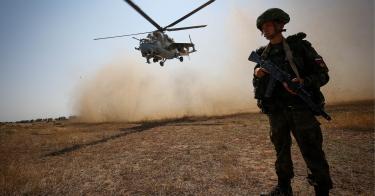Let’s just say the neighbors are nervous.
And why not! Russia’s massive military exercise with Belarus was scheduled to begin today. The war games may have as many as 100,000 Russian and Belarusian troops operating near the Baltic States and Poland.
For these frontline NATO states, the concern is very real.
Some believe that the week-long “Zapad-17” (Russian for West-2017) exercises that Moscow and Minsk are embarking on could be the biggest military training evolution in that part of the world since the Cold War’s end.
That’s significant.
Russia and Belarus insist that troop numbers will be just 12,000 — not the 100,000 others are reporting. Their insistence might have something to do with the fact that if those forces exceed 13,000, international agreements require that they provide “confidence and security-building measures” (in other words, outside observers).
That doesn’t seem to be happening in a meaningful way.
The exercise scenario is also worrisome. It has Russia and Belarus battling three mythical regional countries, “Vesarbia,” “Lubenia” and “Veishnoria,” according to Germany’s Deutsche Welle.
Further, the public broadcasting service reports that the notional enemies control a land corridor which connects (the not-at-all notional) Belarus with (the not-at-all notional) Russian enclave of Kaliningrad on the Baltic Sea.
(Kaliningrad is a chunk of Russian land wedged between NATO members Poland and Lithuania.)
Plus, the (not-at-all notional) land corridor that runs from Belarus to Kaliningrad is known as the Suwalki Gap — which also serves as the border between Vilnius and Warsaw.
Actually, the scenario isn’t very notional at all, is it?
One possible concern (and one that preceded Zapad-17) is that Moscow wants the strategic Suwalki Gap and will use these maneuvers to seize it, geographically dividing NATO and connecting Kaliningrad and Minsk.
It’s not far-fetched: Russia used large exercises to divert attention from, or as staging grounds for, Moscow’s interventions into Georgia (2008) and Crimea, Ukraine (2014).
Others are troubled that some Russian forces and/or equipment deployed to Belarus for Zapad-17 will stay behind in that country to put them closer to NATO borders, Kaliningrad or Ukraine.
So what’s going to happen this next week?
It’s doubtful that Russian President Vladimir Putin (with or without Belarus President Alexander Lukashenko) will make a military move on the Suwalki Gap, activating NATO’s Article 5 — a clause that stipulates that an attack on one is an attack on all.
The same applies to attacking other NATO states.
Frankly, taking on the U.S.-led, 29-member NATO alliance is risky and a much heavier lift than taking on individual countries such as Georgia or Ukraine.
Moreover, Putin is already running an insurgency in Ukraine and supporting the Syrian regime, all while Russia suffers from low global oil and natural gas prices that aren’t filling government coffers as much as usual.
What happens with Russian troops/gear in Belarus is unclear.
The United States, of course, should be loaded for “bear” while Zapad-17 flexes its military might. There’s also the possibility of an incident during the war games (such as accidentally or intentionally crossing a border) that could lead to a crisis.
But beyond any possible intentional or unintentional hostilities, it’s also critically important that we keep our eyes and ears open to study and assess current Russian military doctrine, readiness and capabilities.
Hopefully, it won’t ever be needed, but it’ll sure be helpful if it ever is.
This piece originally appeared in Boston Harald



